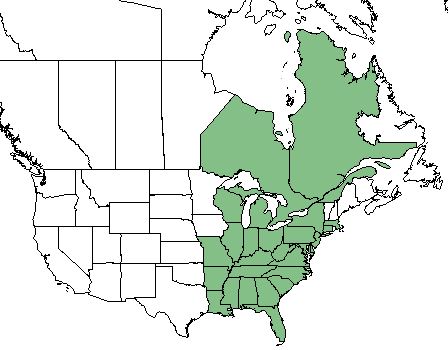Liatris spicata
Common name: dense blazing star[1], florist's gayfeather[2]
| Liatris spicata | |
|---|---|

| |
| Photo by the Illinois Wildflowers Database | |
| Scientific classification | |
| Kingdom: | Plantae |
| Division: | Magnoliophyta - Flowering plants |
| Class: | Magnoliopsida - Dicots |
| Order: | Asterales |
| Family: | Asteraceae |
| Genus: | Liatris |
| Species: | L. spicata |
| Binomial name | |
| Liatris spicata L. | |

| |
| Natural range of Liatris spicata from USDA NRCS Plants Database. | |
Contents
Taxonomic Notes
Synonyms: Laciniaria spicata (Linnaeus) Kuntze.[3]
Varieties: Liatris spicata (Linnaeus) Willdenow var. resinosa (Nuttall) Gaiser; Liatris spicata (Linnaeus) Willdenow var. spicata.[3]
Description
L. spicata is a perennial forb/herb of the Asteraceae native to North America and Canada.[1] This plant grows up to 2 m tall, has a glabrous stem, with the fibers of old basal leaves usually present. The lower leaves are linear to narrowly elliptic, 1-3 dm long, 0.5-1.5 cm wide, and glabrous to pubescent along the midrib. The rachis is glabrous. The involucres are sessile, cylindric, 4-7 mm in diameter, with heads that are 8-flowered. The bracts are obtuse with hydraline margins. The corolla lobes are lavender and 2-4 mm long. The nutlets are pubescent on the ribs with pappus that are antrorsely barbed.[4]
Distribution
L. spicata var. resinosa is found from New Jersey, south to southern Florida, and west to Louisianna. L. spicata var. squarrosa ranges north in Massachusetts, Ontario, and Michigan, south to Georgia, Alabama, Mississippi, and Arizona.[3]
Ecology
Habitat
L. spicata is found in bogs, wet longleaf pine savannas, seepages, prairies, roadsides, and grassy balds.[2] Specimens have been collected from moist loamy soils, sandy ridge, cypress pond edges, pine flatwoods, savanna, disturbed areas such as roadside and ditches, grass-sedge bog, and hardwood hammock.[5]
Liatris spicata is an indicator species for the Panhandle Seepage Savannas community type as described in Carr et al. (2010).[6]
Phenology
L. spicata has been observed to flower in July, September, and October.[7]
Fire ecology
L. spicata is not fire-resistant but has high fire tolerance.[1]
Use by animals
L. spicata has low palatability for browsing and grazing animals.[1] The Palmetto Skipper (Euphyes arpa) has been observed on Liatris spicata; the skipper is practically endemic to Florida.[8]
Diseases and parasites
L. spicata is highly colonized by mycorrhizal fungi.[9]
Conservation and Management
Cultivation and restoration
Photo Gallery
References and notes
- ↑ 1.0 1.1 1.2 1.3 USDA Plant Database https://plants.usda.gov/core/profile?symbol=LISP
- ↑ 2.0 2.1 Weakley, A. S. (2015). Flora of the Southern and Mid-Atlantic States. Chapel Hill, NC, University of North Carolina Herbarium.
- ↑ 3.0 3.1 3.2 Weakley, A.S. 2015. Flora of the southern and mid-atlantic states. Working Draft of 21 May 2015. University of North Carolina at Chapel Hill, Chapel Hill, North Carolina.
- ↑ Radford, A. E., Ahles, H. E., & Bell, C. R. (1968). Manual of the vascular flora of the Carolinas. Chapel Hill: University of North Carolina Press.
- ↑ URL: http://herbarium.bio.fsu.edu. Last accessed: June 2018. Collectors: Loran C. Anderson, A.P. Anderson, R.K. Godfrey, R.L. Lazor, Ginny Vail, John Nelson, John Morrill, R. Kral, Lovett Williams, P.L. Redfearn, C. Jackson, Sidney McDaniel, Robert Doren, H.A. Davis, Steve Orzell, Edwin Bridges, Cecil Slaughter, R.F. Thorne, R.A. Davidson, Wm. G. Atwater, R. Komarek, Lisa Keppner, Katelin Pearson, Donald. Davidson. States and counties: Florida (Franklin, Levy, Washington, Wakulla, Okaloosa, Santa Rosa, Gulf, Escambia, Walton, Calhoun, Bay, Taylor, Bradford, Duval, Palm Beach, Indian River, Baker, Taylor, Liberty, Flagler, Pinellas, Dade, Collier, Volusia) Georgia (Thomas) South Carolina (Georgetown)
- ↑ Carr, S.C., K.M. Robertson, and R.K. Peet. 2010. A vegetation classification of fire-dependent pinelands of Florida. Castanea 75:153-189.
- ↑ Nelson, G. PanFlora: Plant data for the eastern United States with emphasis on the Southeastern Coastal Plains, Florida, and the Florida Panhandle. www.gilnelson.com/PanFlora/ Accessed: 24 MAY 2018
- ↑ Observation by Edwin Bridges in Highlands County, December 26, 2016, posted to Florida Flora and Ecosystematics Facebook Group.
- ↑ Anderson, R. C. and E. S. Menges (1997). "Effects of fire on sandhill herbs: nutrients, mycorrhizae, and biomass allocation." American Journal of Botany 84: 938-948.